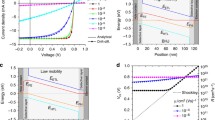Abstract
In this work, we have developed a theoretical study based on the classical traditional approach. In fact, the application of the fundamental dynamics relationship in the steady-state regime, taking into account both friction and Lorentz forces, allowed us to determine the velocity components of charge carriers, namely, electrons and holes. By applying Ohm's law, we determined the matrix of electrical resistivity. Knowledge of the resistivity \({{\varvec{\rho}}}_{{\varvec{x}}{\varvec{x}}}\) in the direction of the current and the dimensions of the solar cell allowed us to determine the expression for longitudinal resistance RL as a function of the magnetic field B. Similarly, from the formula for resistivity \({{\varvec{\rho}}}_{{\varvec{y}}{\varvec{x}}}\), we determined the expression for transverse resistance RT as a function of B. A qualitative comparison between RT and RL shows that RT is negligible compared to RL. Consequently, we turned our attention to the impact of the magnetic field on RL, and our theoretical study revealed that it increases with the increase in B. Once this theoretical study has been proposed, it must undergo testing to ensure its validity. Therefore, it is subjected to two tests: one under illumination, for which we referred to the work of Dioari Ulrich Combari et al. (Adv Condens Matter Phys 18:1, 2018). To extract the parameters \({I}_{SC}\), \({I}_{0}\), \({R}_{S}\), \({R}_{Sh}\), n, and \({V}_{OC}\) of the cell, we employed our method of least squares (LMS). The other test is conducted in the dark and is carried out by El-Aasser et al. (Intern J Adv Appl 3:196, 2014) in the presence of a magnetic field B under both direct and indirect biasing conditions. Both tests demonstrate that our theoretical study is in perfect agreement with practical results. In fact, an increase in the intensity of the magnetic field beyond 1 millitesla (mT) automatically results in an increase in the series resistance RS, denoted as RL in our study. Ultimately, an increase in RS leads to a direct decrease in current, maximum power, and efficiency.







Similar content being viewed by others
References
D U Combari, E W Ramde, I Sourabie, M Zoungrana, I Zerbo and D J Bathiebo Advances in Condensed Matter Physics 18 1 (2018)
M E Aasser, A Ibrahim and S M Musa Intern. J. Adv. Appl. 3 196 (2014)
M P Ndeto, D W Wekesa, R Kinyua and F Njoka Renew. Ener. 159 184 (2020)
I Zerbo, M Zoungrana, I Sourabie, A Ouedraogo, B Zouma and J Bathiebo Turk. J. Phys. 39 288 (2015)
M Zoungrana, I Zerbo and A Sere Global. J. Eng. Res. 10 113 (2011)
H Fathabadi Energy. 116 402 (2016)
H Fathabadi Mater. Chem. Phys. 244 122684 (2020)
H Fathabadi Appl. Energy. 173 448 (2016)
D Aji and P Pakawatpanurut Solar. Energy. 233 204 (2022)
H Fathabadi J. Mater. Scie. 30 17314 (2019)
S Erel Sol. Energy Mater. Sol. Cells. 71 273 (2002)
S Erel Teknoloji. 11 233 (2008)
F I Barro Indian J. Pure. Appl. Phys. 53 590 (2015)
M Zoungrana, I Zerbo, B Soro, M Savadogo, S Tiedrebeogo and D J Bathiebo J. Adv. Sci. Tecnol. Res. 11 133 (2017)
H Fathabadi Inter. J. Green. Energy. 17 440 (2020)
S O Casado, A Urbina and J Prior Scientific. Reports. 42 977 (2017)
I Zerbo, M Zoungrana, A D Seré and F Zougmoré IOP Conf. Series. 29 012019 (2012)
H Fathabadi J. Mater. Scie 30 17314 (2019)
I Sourabié, I Zerbo, M Zoungrana, D U Combari and D J Bathiebo J. Smart. Grid. Clean. Energy. 8 325 (2017)
P Drude Zur Elektronentheorie der Metalle, en Annalen der Physik. 306 566 (1900)
M P Marder Condensed Matter Physics, 2nd edn. (A John Wiley & Sons Inc: Publication) p 453 (1999)
Y Y Peter and C Manuel Electrical Transport Fundamentals of Semiconductors Physics and Materials Properties (Fourth Edition, Springer) p 203 (2010)
A Crépieux Transport semi-classique Introduction à la physique de la matière condensée Propriétés électroniques (Dunod, Paris) p 133 (2019)
N W Ashcroft and N D Mermin Modèle semi-classique de la dynamique des électron Physique des Solides p 253 (2002)
A H AlBayati Indones J. Electr. Eng. Comput. Sci. 31 713 (2023)
Y Baba and M Bouzi Int J. Power. Electron. Drive. Syst. 12 695 (2021)
H S Naji and H I Hussein Indones. J. Electr. Eng. Comput. Scie. 22 1 (2021)
A Jain and A Kapoor Sol. Energy. Mater. Sol. Cells. 81 269 (2004)
M Khalis and Y Mir Phys. J. Appl. Phys. 54 10102 (2011)
M Khalis, R Masrour, G Khrypunov, M Kirichenko, D Kudiy, M Zazoui and J Physics Conference Series 758 012001 (2016)
Acknowledgements
We would like to express our gratitude to the research team led by D. Ulrich Combari and his collaborators, as well as to the research team led by M. El-Aasser and his collaborators, to use their experimental results to verify and validate our study. Their contribution has been of invaluable importance in advancing our research.
Author information
Authors and Affiliations
Corresponding author
Additional information
Publisher's Note
Springer Nature remains neutral with regard to jurisdictional claims in published maps and institutional affiliations.
Rights and permissions
Springer Nature or its licensor (e.g. a society or other partner) holds exclusive rights to this article under a publishing agreement with the author(s) or other rightsholder(s); author self-archiving of the accepted manuscript version of this article is solely governed by the terms of such publishing agreement and applicable law.
About this article
Cite this article
Khalis, M., Masrour, R. Impact of the magnetic field on solar cell parameters: A study using the conventional classical approach. Indian J Phys (2023). https://doi.org/10.1007/s12648-023-03045-8
Received:
Accepted:
Published:
DOI: https://doi.org/10.1007/s12648-023-03045-8




